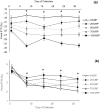Stable isotopes of C and N differ in their ability to reconstruct diets of cattle fed C3-C4 forage diets
- PMID: 36229636
- PMCID: PMC9562360
- DOI: 10.1038/s41598-022-21051-4
Stable isotopes of C and N differ in their ability to reconstruct diets of cattle fed C3-C4 forage diets
Abstract
Stable isotopes are useful for estimating livestock diet selection. The objective was to compare δ13C and δ15N to estimate diet proportion of C3-C4 forages when steers (Bos spp.) were fed quantities of rhizoma peanut (Arachis glabrata; RP; C3) and bahiagrass (Paspalum notatum; C4).Treatments were proportions of RP with bahiagrass hay: 100% bahiagrass (0%RP); 25% RP + 75% bahiagrass (25%RP); 50% RP + 50% bahiagrass (50%RP); 75% RP + 25% bahiagrass (75%RP); and 100% RP (100% RP). Feces, plasma, red blood cell (RBC), and hair were collected at 8-days intervals, for 32 days. Two-pool mixing model was utilized to back-calculate the proportion of RP based on the sample and forage δ13C or δ15N. Feces showed changes using δ13C by 8 days, and adj. R2 between predicted and observed RP proportion was 0.81 by 8 days. Plasma, hair, and RBC required beyond 32-days to reach equilibrium, therefore were not useful predictors of diet composition during the study. Diets were best represented using fecal δ13C at both 8-days and 32-days. By 32-days, fecal δ15N showed promise (R2 = 0.71) for predicting diet composition in C3-C4 diets. Further studies are warranted to further corroborate fecal δ15N as a predictor of diet composition in cattle.
© 2022. This is a U.S. Government work and not under copyright protection in the US; foreign copyright protection may apply.
Conflict of interest statement
The authors declare no competing interests.
Figures




References
-
- Gregorini P, Villalba JJ, Provenza FD, Beukes PC, Forbes JM. Modelling preference and diet selection patterns by grazing ruminants: A development in a mechanistic model of a grazing dairy cow. MINDY Anim. Prod. Sci. 2015;55:360–375. doi: 10.1071/AN14472. - DOI
-
- Allen VG, et al. An international terminology for grazing lands and grazing animals. Grass Forage Sci. 2011;66:2–28. doi: 10.1111/j.1365-2494.2010.00780.x. - DOI
-
- Jones RJ, Ludlow MM, Troughton JH, Blunt CG. Estimation of the proportion of C3 and C4 plant species in the diet of animals from the ratio of natural 12C and 13C isotopes in the faeces. J. Agric. Sci. 1979;92:91–100. doi: 10.1017/S0021859600060536. - DOI
-
- Fry B. Stable Isotope Ecology. Springer; 2006.
Publication types
MeSH terms
Substances
LinkOut - more resources
Full Text Sources
Miscellaneous

